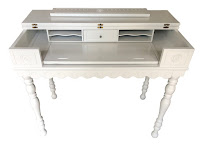 |
| Spline Cane Before |
 |
| Spline Cane After |
If someone were to ask what our most common refinishing job is, I’d have to answer “Chairs.” The reason is simple. We all use them, so we all have them and at some point in time, they will need to be either refinished, reupholstered, restored or in this case, re-caned. This dining chair was in need of a new spline caned back (only) as the seat covers would remain fabric (to be done at a later date).
This is one of a set of four chairs in need of new back cane. It is a “spline” cane style, which means that the back portion is made of a single sheet of caning then kept in place with a spline that keeps the cane sheet in place. This is the first time I have worked with this particular style of caning, which is known as Swedish woven. The difference between this type of cane and the more commonly seen antique cane is that these are double rows of perpendicular lines that criss-cross compared to “hole” style of cane.
When ordering caning supplies, it is very important to measure the width of the channel to get the right size of spline. If you order spline that is too large, it won’t fit into the channel, which can cause damage during the tapping which is an essential part of the installation. If you order spline that is smaller than the channel, it won’t fit tight enough to keep the cane from coming out, so ordering the proper size is key.
 |
| Cleaned out channel |
The hardest part of this process is removing the old spline. For these chairs, I used a combination of tools; chisel, needle-nose pliers, wood-carving tools, hammer, and then later (after I ordered it) a spline-removal tool, which is exactly the perfect tool to get beneath the old spline and smack it until it lifts up. I then used a small chisel to loosen any remaining spline that stuck to the inside of the channel.
Note: Cane
must be soaked prior to installation. I soaked the cane and
 |
| Soaking Cane in Tub |
spline (in my bathtub) for over an hour. (My little cat, Sadie is supervising!) Soaking spline and cane together is necessary, so that the spline can be manipulated around the tight corners that bend along the edges of the chair. It is okay to leave the everything soaking while you continue to work on each chair. By the time you get to the last chair, your cane and spline will be pliable enough to work easily. The first one is always the hardest one to work on.
I used Frog tape to protect the chair from accidental scratches while removing the old spline. Once the spline was removed and the channel cleaned out, (see photo at left), it is ready to accept the new cane and spline, which gets tapped into place with hammer and caning wedges. This process is tedious and time consuming and you really must focus on the work, which means no distractions!
The basic dynamic of installation is the same as hole cane, but the challenge of this style is to keep the rows straight vertically as well as horizontally, as they tend to shift while you install the spline. Once you have tapped the cane down enough to accept the spline
(keep it in place with caning wedges) you can then carefully apply clear drying glue into the channel, then follow it with the new spline, being conscious of carefully bending and fitting it around those tight corners. (If your chairs have larger curves, it is much easier to install spline).
Of the two ways of cane installation, spline or hand weave, this is the “easier” way to do it, but that doesn’t mean it’s simple. It takes precision, patience and the right tools to do it right.








































